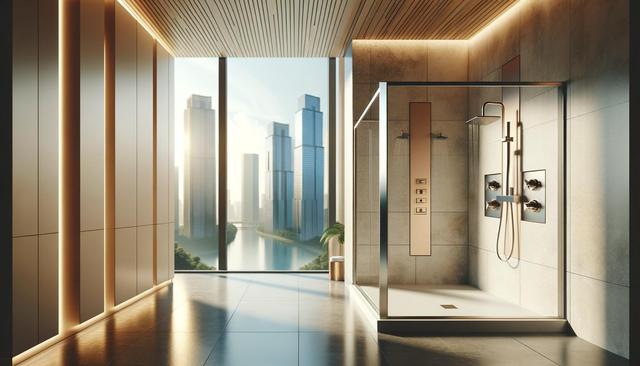Understanding the Appeal of Walk-In Showers
Walk-in showers have grown in popularity due to their clean design and user-friendly features. Unlike traditional shower-tub combinations, walk-in showers offer easy access, making them ideal for people of all ages and mobility levels. They also contribute to a more spacious and open feel in the bathroom. Homeowners often choose walk-in showers for their ability to enhance both functionality and aesthetics. With a wide variety of styles, materials, and configurations available, these showers are suitable for both compact bathrooms and larger, luxurious spaces. Their minimal threshold entry and seamless glass panels give a contemporary look that complements modern interior design.
Before selecting a walk-in shower, it’s important to consider your household’s specific needs. For example, if accessibility is a priority, look for models with low or no threshold entries, slip-resistant flooring, and grab bars. Those focused on style might prioritize frameless glass panels or custom tile work. Understanding your motivations helps narrow down the available choices and ensures your purchase aligns with your expectations.
Key Features to Consider Before Buying
The process of choosing a walk-in shower goes beyond just visual appeal. Practical features significantly impact the overall experience and usability. A few essential elements to assess include:
- Size and Layout: Ensure the shower fits comfortably within your bathroom dimensions.
- Material: Options like acrylic, fiberglass, tile, or natural stone each offer different maintenance and aesthetic qualities.
- Door Style: Walk-in showers can be doorless or feature sliding, hinged, or bi-fold doors, depending on your space.
- Drainage: Proper drainage is key to preventing water pooling and potential damage.
- Ventilation: Adequate airflow is necessary to prevent mold and mildew buildup.
Additionally, consider whether you want a prefabricated unit or a custom-built design. Prefab models are typically more budget-friendly and quicker to install, while custom designs offer a tailored solution suited to your specific space and style preferences.
Design Options and Customization
One of the most appealing aspects of walk-in showers is the ability to customize their look and functionality. From tile patterns to hardware finishes, there are countless ways to personalize the design. Some common customization elements include:
- Wall and Floor Tiles: Choose from ceramic, porcelain, or natural stone with various textures and colors.
- Showerheads: Options range from fixed to handheld, rainfall, or multi-jet systems.
- Storage: Built-in niches or shelves provide convenient storage for toiletries.
- Lighting: Integrated LED lighting can enhance the ambiance and visibility.
These features not only contribute to the shower’s appearance but also improve its practicality. For instance, built-in seating and adjustable showerheads are perfect for those seeking comfort and accessibility. By combining functional and decorative elements, walk-in showers can be tailored to meet a range of tastes and requirements.
Installation Considerations and Planning
Installing a walk-in shower requires careful planning and professional guidance. It’s essential to evaluate your bathroom’s existing layout and plumbing to determine what modifications are necessary. Working with a contractor or bathroom specialist helps ensure the project is completed safely and efficiently. Key factors to address during the planning phase include:
- Plumbing Adjustments: Relocating drains or water lines may be needed depending on the new shower’s layout.
- Waterproofing: Proper sealing and waterproof membranes prevent water damage over time.
- Floor Slope: The floor must be angled appropriately for effective drainage.
- Permits: Depending on your location, you may need to secure building permits before beginning work.
Timing and budget are also crucial. While prefabricated units may be installed in a few days, custom showers could take several weeks, especially if structural changes are involved. Budgeting for both materials and labor ensures there are no surprises along the way.
Maintenance and Long-Term Value
Once your walk-in shower is installed, maintaining it is key to preserving its appearance and functionality. Fortunately, many walk-in showers are designed with ease of maintenance in mind. Glass panels should be wiped down regularly to prevent water spots and soap residue. Tile and grout lines may require periodic sealing to prevent mildew, while acrylic surfaces can be cleaned with non-abrasive solutions. Consider these maintenance tips:
- Use a squeegee after each use to reduce water spots.
- Clean tiles and grout weekly to minimize buildup.
- Inspect drainage and seals occasionally to prevent leaks.
- Choose easy-to-clean materials for long-term convenience.
In addition to their practical benefits, walk-in showers can also enhance property value. Potential homebuyers often view updated bathrooms as a major selling point. A well-designed and properly maintained walk-in shower can offer a return on investment by improving both daily living and resale potential.
Conclusion: Making the Right Choice for Your Bathroom
Walk-in showers offer a balance of style, accessibility, and practicality that suits a wide range of homeowners. Whether you’re planning a full bathroom remodel or simply upgrading your current shower, understanding your space, needs, and available options is essential. From layout and design to installation and maintenance, taking a thoughtful approach ensures your walk-in shower will serve as a functional and attractive feature for years to come. By focusing on quality materials, smart planning, and personal preferences, you can make a confident, informed decision that enhances your home and meets your lifestyle needs.


